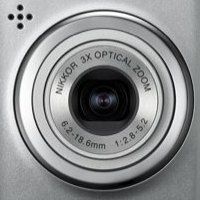The Nikon “L” or Life series of cameras are designed to be simple to use family snappers but provide a breadth of features and gadgets that allow good picture taking without to much fiddling about. As such, the L10 sits beneath the L12 and the L11 and above the L5 in the range and so offers a suitably medium feature set – as befits its middling position in the range.
Our quick take
The L10’s focusing issues and the problems with the auto white balance are reminiscent of the L12 I recently tested, but you have to bear in mind this is a budget model and compromises must be made when you’re on a budget.
It is still a budget model that nevertheless packs in some neat extras that elevate it above being just a simple snapper.

Nikon Coolpix L10 digital camera - 3.5 / 5
| FOR | AGAINST |
|---|---|
|
|
The key features include a 5-megapixel sensor sat inside the silver-liveried plastic-but-well-made body. A bright F2.8 to F5.2, 3x optical zoom lens provides a focal range of 37.5mm to 112.5mm; what Nikon calls the “key photographic range”. A wider, wide end would help here in my view, but it is nonetheless about average at this level. However, the lens does suffer from barrel distortion at the wider end, so perhaps an even wider angle is not a good idea.
The camera is a little curvy chunk; pocketable in a plump sort of way but not unattractively so and the features you get to assist your snapping include some unusual ones at this price. For example, Face Priority AF, which worked rather well in most “normal” conditions but similarly to the higher specified L12, in low light or when snapping anything remotely challenging or of low contrast, the AF performance was simply frustratingly poor and often refused to focus no matter what I tried.
Handling is straightforward thanks to a simple control layout that sees a large shutter button and on/off control on the top plate with the remainder of controls on the back. Sliver-like zoom buttons sit snuggly into the top right hand side while menu and playback buttons sit nearest the screen. A four-way jog control provides the scrolling tools in menus or image playback and each segment doubles up with controls for flash (top), exposure compensation (right, and the camera’s one “manual” override), macro (bottom) and the self timer. A central OK button is used to select options in menus etc.
A dedicated delete button is placed just above a small slider control that switches between still, movie recording and the scene modes; options for the latter are accessed by pressing the menu button. All fairly simple and very quick to get used to.
White balance control (within menus) includes the usual presets of daylight, cloudy, flash and incandescent to name a few and, on a more positive note, manual white balance control is included another benefit for this price range. But it is a good job it’s there because the auto white balance control shows some extreme swings of colours; yellows and oranges, occurs when using flash indoors for example in mixed lighting.
The usual array of scene modes and flash options plus a nice 640x480-pixel movie mode with sound at 30fps, mean you do have scope to play, despite there being no ISO control. Scene modes include panorama, landscape, night portrait, sports and portrait modes and it is in the scene settings you also find the Face priority AF set up.
Other functions that help are the in-camera redeye fix system and Nikon’s D-Lighting technology that can boost shadows for underexposed shots without adversely affecting the highlights or correctly exposed areas in a shot.
The L10’s 2-inch LCD is nice to use and packs 153,000-pixels, making it rather better to use than that on the L12. No problems with flare for example and images look suitably detailed too. However, the lack of an optical viewfinder means there’s little option but to struggle through brighter conditions, the screens one Achilles heel.
Metering is rather good with exposures rarely compromised even in quite challenging conditions and because of the lack of control over ISO, the top setting of ISO 800 comes into play far to often for my liking.
The camera will pick higher ISO settings as the light levels drop, which introduces noise – even if you use, say, a tripod to steady the camera – the lack of ISO control means you cannot keep noise down by using lower ISO modes.
Start up time is around two seconds and you wait around about two and a half seconds between shots. Turn on the flash though and as the flash recycles, the shot to shot time is around four and a half seconds. The camera locks up totally as well while the flash recharges which is annoying to say the least and not particularly family friendly, shooting anything other than set up shots can is less than spontaneous.
Low ISO image quality is excellent – the lens can get a reasonable level of detail out of the available pixels and noise is minimal up to around ISO 200. Above that setting, noise starts to become obvious at ISO 400 and bad at the highest ISO 800 setting. Images are saved to either the 7MB of internal memory (that’s enough for three top quality images) or on SD/MMC external storage.
Colours are normally naturally rendered but the problems with the auto white balance indoors means under those conditions colours can become wildly skewed. When you get over ISO 400 noise and image-processing problems can create slight issues with colour as well but not to a horrendous degree.
To recap
The Nikon Coolpix L10 is the L12’s little sister and as such offers similar performance but with lower resolution and sans that camera’s optical image stabilisation. It also suffers from all the problems the L12 has, only more so.
